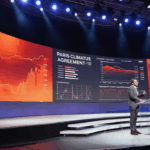In April 2021, the European Commission adopted the proposed Corporate Sustainability Reporting Directive (CSRD). This is undoubtedly a key step towards streamlining access to quality ESG data. Given the CSRD will replace the NFRD in 2023, Ksapa shares its analysis of what to expect – and how to prepare for it.
Anticipating the transition from the NFRD to the CSRD
Reframing the NFRD
A regulatory initiative spanning the European market, the European Non-Financial Reporting Directive initiated the harmonization of non-financial reporting in 2014.
Since the 1990s, various initiatives have proved instrumental in streamlining and improving access to quality ESG data. The private sector formalized key milestones, through rating agencies, on one hand – and public interest organizations such as the GRI or CDP, on the other. Much in the same way, public regulatory initiatives, such as France’s NRE Law of 2001, or China’s 2006’s corporate law promoted the development of non-financial data as well as its reliability and comparability.
With the NFRD, the European Commission took a major step towards regimenting non-financial reporting. It indeed required some 11,000 companies (with more than 500 employees and based in the European Union) to provide the following information:
- Environmental issues;
- Social issues, including the treatment of employees;
- Human Rights reporting – aligning with the Guiding Principles on Business and Human Rights in conjunction with the revision of the OECD guidelines;
- The fight against corruption and bribery;
- Diversity on company boards (age, gender, education and professional experience).
That said, the NFRD will remain in effect until 2023. In our current transition period, it remains the reference, notably for the implementation of the new Green Taxonomy.
The Importance of Materiality and ESG Reporting Guidelines
The NFRD left quite a bit of room for interpretation in determining the materiality of any given data. For instance, the Danish transcript of 2015 emphasized the ability of companies to self-identify material issues. Stakeholder dialog was indeed expected to finetune assessments over time, should companies fail to publish information on their most relevant topics.
Such an approach lends itself to the obvious risk of major issues slipping through the cracks. This is particularly true of constantly evolving environmental, ethical and social issues as their gaining in maturity over the years. Building on the the Grenelle 2 law of 2010, France invited companies to publish information on a list of around forty indicators. In that scenario, the risk was to drown critical issues as part of a reporting exercise that (at least in theory) left little room for sectorial specificities.
Looking at Danish and French approaches alike, materiality has therefore gained importance to focus ESG reporting on clear, transparent and constructive priorities guiding ESG reporting activities.
The legacy of the NFRD (2014-2023)
- At the European level, the NFRD pushed a significant number of companies to think, create, share and dialog around non-financial information. This helped shape a common understanding of new reporting expectations among listed companies, banks and insurance companies. This notably allowed them to collectively catch on to the importance of various environmental issues – climate change, for one – and social issues – including gender equality.
- Non-financial materiality exercises were already being carried out in the 2000s. For the sake of greater readability and relevance, they became commonplace in the 2010s. In fact, they were key in focusing non-financial reporting on the most important issues – for companies and investors alike.
- In an effort to ensure consistency, the NFRD gave rise to various other European initiatives. This considerably clarified and standardized reporting exercises. In 2017, the European Commission for instance published its guidelines to help companies publish environmental and social information, followed by the Guidelines on Climate-Related Reporting. The Sustainable Finance Disclosure Regulation of 2019 promoted the principle of double materiality. It encouraged companies to look in both directions, ultimately making the process more rigorous. The goal was to avoid reasoning solely in terms of corporate interests and omitting a rigorous review of impacts.
The Structural Weakness of ESG Data
While these efforts have been echoed by various national and international initiatives, non-financial reporting as it stands still suffers from a threefold structural weakness:
1. ESG data has yet to become fully actionable for economic decision-makers or investors
Listed companies’ reports typically rely on aggregated information. This fails to fully reflect a company’s specific markets and business lines. It does not support comparability among competitors nor does it foster sufficient granularity in value chain data. In fact, numerous initiatives turned to Big Data to address this bias, though with limited success. This is notably because of the two other structural limitations described below.
2. ESG data does not sufficiently cover small and medium-sized companies
This despite the fact they represent 90% of our global economy. As such and from a SME or VSE viewpoint, ESG reporting often amounts to answering a few questionnaires, signing a few charters. Perhaps partaking in various programs. This does not mean SME do not invest in environmental, ethical or social issues…It’s quite the contrary. There clearly is room for improving reporting ESG data. Eventually assess value chain performance in a relevant, reliable and comparable manner.
3. ESG issues are difficult to encapsulate in quantitative data
This in turn limits the effectiveness of the reporting exercise. For instance, assessing the number of signatories of a company’s Human Rights Charter among Tier 1 suppliers is relatively straightforward. The resulting ESG data point is fairly simple. A company can state “90% of my suppliers have signed this charter”. There is however little proof such a charter is effectively applied across corporate activities. Nor is there any evidence that Tier 1 suppliers collect granular information on most salient Human Rights issues. Decision-makers need to go further in their assessments.
Progress Tied to the CSRD
Key Principles of the CSRD
The CSRD signals just how much non-financial reporting matured in the last decade. There is, however, much room for improvement.
From a practical viewpoint, implementing the CSRD from 2023 onwards follows 5 core principles:
- Sustainability reporting as intended by the CSRD will apply to no less than 50,000 European companies. As such, the scope of the new directive clearly extends to a large number of SME.
- The initiative encourages ESG disclosure in business transactions between investors and issuers and across value chains.
- The CSRD involves the digitization of standardized ESG data. Thus, across the European market. This effort will make a world of difference in collecting and assessing investors’ and asset managers’ ESG data.
- The CSRD will make the auditing of ESG information mandatory. This will undoubtedly bolster the robustness and reliability of extra-financial data. It is often criticized for poor comparability.
- The CSRD takes a further step towards integrated reporting. It requires corporate reports to combine financial and non-financial information against a series of mandatory issues. As such, CSRD terminology in and of itself is not insignificant: it is about sustainability reporting, not just non-financial information – as with the NFRD.
Mainstreaming Best Practices Though the CSRD
The CSRD also seeks to mainstream various practices that are already widely implemented in the most advanced groups:
- Promoting dual materiality, already developed among large groups since 2019;
- Explicating the role of managers in supporting corporate socio-environmental policies. Over the past 25 years, books and conferences have repeatedly cited their mobilization as an essential ingredient of any effective approach;
- Favoring flexibility. This makes reporting tools more absorbable by smaller structures. Actually given they cannot necessarily devote full-time resources to ESG data collection and reporting. For the past 20 years, large groups have adopted that same approach to collect information from subcontractors. Indeed, they are using questionnaires and software facilitates the process, encouraging self-reporting or updating of data collected from previous campaigns.
ESG Reporting Requirements in The CSRD
Entities covered by the CSRD will be required to report on:
- Their business model and strategy;
- Their sustainability goals and progress towards achieving them;
- The role of their administrative, management and governance bodies in relation to sustainability;
- Their sustainability policies;
- Their most significant negative impacts on sustainability issues;
- Key risks related to sustainability issues – including their main dependencies on these issues and how they manage these risks;
- How they have identified the information around which to structure their reports.
In short, the CSRD requires companies to provide information that is altogether:
- Qualitative and quantitative;
- Prospective and retrospective;
- Specific to the short, medium and long-term.
Companies’ reports will also need to include information about their value chain. This includes their operations, products and services, business relationships and supply chains.
Mandatory ESG Reporting Topics in the CSRD
The CSRD is expected to introduce mandatory sustainability reporting standards on the following socio-environmental issues.
Information regarding environmental factors, notably including:
- Climate change mitigation and adaptation;
- Water and marine resources;
- Resource use and the circular economy;
- Pollution;
- Biodiversity and ecosystems.
Information on social factors spanning the following issues:
- Equal opportunities – including gender equality and equal pay for equal work, training and skills development as well as employment and inclusion of people with disabilities ;
- Working conditions – including job security and adaptability, wages, social dialogue and worker participation, work-life balance and a healthy, safe and appropriate working environment;
- Human Rights, fundamental freedoms, democratic principles and standards.
Information on governance factors, involving:
- Oversight bodies – including their composition and how they address sustainability factors;
- Business ethics and corporate culture – including anti-corruption and anti-bribery policies;
- Corporate political commitments – including lobbying activities;
- The management and quality of relationships with business partners – including payment terms;
- Corporate internal control and risk management systems – including reporting processes.
Towards International Convergence
The CSRD is consistent with the ambitions of the European Green Deal. It logically aligns with the existing European legal framework encapsulated in the SFRD and the new Green taxonomy. Its purported goal is to reduce complexity – or any potential duplication of reporting efforts. This is an essential step towards amplifying the transfer of liquidities in favor of sustainable finance and mobilizing SME.
The European Financial Reporting Advisory Group will be responsible for the operational implementation of relevant tools and standards over the coming years. The European Commission has therefore called for a CSRD governance body to ensure full alignment with the G20, G7 and Financial Stability Board initiatives, among other likeminded efforts. In so doing, it fosters common understanding around global sustainability reporting standards. This also builds on the recommendations of the Climate Disclosure Task Force.
In that context, the International Financial Reporting Standards Foundation’s suggestion to create a new Sustainability Standards Board could not be more timely. The same extends to established initiatives, including the Global Reporting Initiative, the Sustainability Accounting Standards Board, the International Integrated Reporting Council, the Climate Disclosure Standards Board and the CDP.
Conclusion
The number of companies covered by the expansion of CSRD reporting requirements will quadruple by 2023. The 50,000 or so companies subject to these new expectation are at the heart of value chains. They in turn involve numerous suppliers and subcontractors.
The CSRD is set to mainstream reporting systems. Notably through the technical specifications it will issue. It should be noted that the European Commission expects to differentiate its standards for large companies. Effectively adopting separate and “proportionate” standards for SME. Unlisted SME may however refer to the latter on a voluntary basis. A significant departure, this is bound to have a significant impact on key specifications and market rules for the years to come.
With decades of expertise on the topic, Ksapa specializes in calibrating and reporting financial and non-financial information. Our team develops and implements evaluation and critical analysis methodologies. We help companies and investors comply with concomitant reporting requirements. We indeed work to align the EU taxonomy, the SFRD and the NFRD/CSRD. Ultimately helping your teams better leverage liquidities and efforts. On this basis, we support sustainable and just transitions in the face of the socio-environmental and ethical challenges to come.
Author of several books and resources on business, sustainability and responsibility. Working with top decision makers pursuing transformational changes for their organizations, leaders and industries. Working with executives improving resilience and competitiveness of their company and products given their climate and human right business agendas. Connect with Farid Baddache on Twitter at @Fbaddache.






